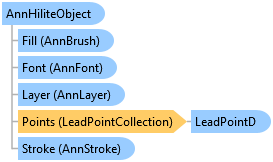| Leadtools.Annotations.Core Namespace : AnnHiliteObject Class |

public class AnnHiliteObject : AnnRectangleObject, IAnnObjectCloneable
Public Class AnnHiliteObject Inherits AnnRectangleObject Implements IAnnObjectCloneable
public sealed class AnnHiliteObject : IAnnObjectCloneable
@interface LTAnnHiliteObject : LTAnnRectangleObject<NSCoding,NSCopying>
public class AnnHiliteObject extends AnnRectangleObject
function Leadtools.Annotations.Core.AnnHiliteObject()
The hilite annotation object is a simple rectangle that has a bounding rectangle, no pen and no brush. Although it does not have a pen or brush, it does have a color value that is used to fill this bounding area. By default the hilite object's fill color is yellow.
With the automated functions, the user clicks / taps and drags to specify the rectangle in the current window.
Programmatically, the boundaries and location of the hilite object can be controlled using the following properties:
Each object can be transformed with the following methods:
The AnnHiliteObject class inherits a number of properties from the AnnObject class, providing support for font, stroke and fill characteristics. These properties are listed below:
The name of the hilite object can be controlled using AnnObject.Labels property, inherited from the AnnObject class.
An object can be part of a group annotation object or part of a container object. It cannot be part of both a group and a container at the same time.
The following properties can also be used to programmatically set characteristics of an AnnHiliteObject:
 Copy Code
Copy Code
using Leadtools.Annotations.Automation; using Leadtools.Annotations.Core; using Leadtools.Codecs; using Leadtools.WinForms; public void AnnCore_AnnHiliteObject() { // assumes _automation is valid double inch = 720.0; // Add a hilite object AnnHiliteObject hiliteObj = new AnnHiliteObject(); // Set the points for the hilite hiliteObj.Points.Add(LeadPointD.Create(1 * inch, 1 * inch)); hiliteObj.Points.Add(LeadPointD.Create(2 * inch, 1 * inch)); hiliteObj.Points.Add(LeadPointD.Create(2 * inch, 2 * inch)); hiliteObj.Points.Add(LeadPointD.Create(1 * inch, 2 * inch)); // Add the object to the automation container _automation.Container.Children.Add(hiliteObj); // Select the object _automation.SelectObject(hiliteObj); }
using Leadtools.Converters; using Leadtools.Annotations.Automation; using Leadtools.Controls; using Leadtools.Annotations.Core; using Leadtools.Codecs; [TestMethod] public void AnnCore_AnnHiliteObject() { // assumes _automation is valid double inch = 720.0; // Add a hilite object AnnHiliteObject hiliteObj = new AnnHiliteObject(); // Set the points for the hilite hiliteObj.Points.Add(LeadPointDHelper.Create(1 * inch, 1 * inch)); hiliteObj.Points.Add(LeadPointDHelper.Create(2 * inch, 1 * inch)); hiliteObj.Points.Add(LeadPointDHelper.Create(2 * inch, 2 * inch)); hiliteObj.Points.Add(LeadPointDHelper.Create(1 * inch, 2 * inch)); // Add the object to the automation container _automation.Container.Children.Add(hiliteObj); // Select the object _automation.SelectObject(hiliteObj); }